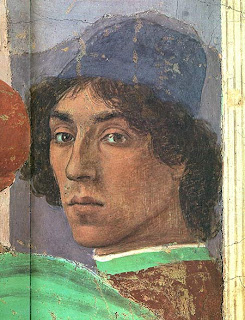It's been nearly a week since Chas and Mavis left and our next visitors arrive tomorrow! This morning I arrive in Florence nice and early for work, only to find my English lesson at the Gucci shop has been cancelled at the last minute. (Although I should still get paid for it) So I can either get back on the bus and go home or do something else...decisions, decisions!
The Brancacci Chapel is just across the Ponte Santa Trinita and I'm ready to be impressed...
Masaccio self portrait
The Chapel is inside the church of Santa Maria del Carmine and in 1423, Florentine merchant, Felice Brancacci, commissioned a fresco of the life of his favourite apostle, Saint Peter. He chose the artist, Masolino, who together with his young pupil and 19 years his junior, Masaccio, (whose real name was Tommaso di ser Giovanni di Simone. His nickname, Masaccio, came from 'Maso' from Tommaso, meaning 'big', 'fat' or 'messy' Tom and used to distinguish him from his master Masolino, 'little' or 'delicate' Tom) started the fresco cycle. They worked on it together from 1423 to 1424 and again from 1427 to 1428 and then Masaccio left for Rome. He died there only a few months later at the age of only 27. In 1436 Brancacci, who was an enemy of the Medici, fell into disgrace and was exiled and the fresco was not finished until 1436, by Filippino Lippi. The frescoes were damaged by fire in 1771 and underwent a restoration between 1983 and 1990.
The expulsion of Adam and Eve
This is no ordinary Fresco and is sometimes referred to 'the Sistine chapel of the early Renaissance'. At the time it was being painted, many artists of the time, such as Michelangelo, Leonardo, Raphael, Boticelli etc. would go along and study from it and make sketches of it. At the time there were no art books for these artists to study and the art of drawing, painting and perspective that the Greeks had mastered, as this had been lost for over a thousand years... It was Masaccio they came to study! It was he who made the bridge from Cimabue and Giotto's masterful beginnings and added the re-discovery of perspective, shadowing, use of narrative drama and tragic reality of human figures, which proved to be a schooling for these famous ‘artists to be'.
As I move round the Chapel I am left open-mouthed at the beauty and honesty of these somewhat crude figures. The restoration has rendered the colours very bright. The sheer shame of Adam and Eve at being expelled from the Garden of Eden, the humanity of Peter, in his orange cloak as he heals the sick, portrayed for the first time here in their tragic state. Also here is Masaccio’s absolute masterpiece of ‘Peter and the story of the tribute money.’
The story is told in three parts in this large fresco. As first in the middle, the tax collector requests the money from Jesus, then on the left, Peter bends down to the lake where he finds the coins in the mouth of the fish and finally, on the right, Peter gives the money to the tax collector.
The depth of colours, use of aerial perspective and vanishing points were all unprecedented at this time and Masaccio is credited with re-inventing these lost techniques. Masaccio’s work contrasts with the more formal frescoes of Masolino and finally Filippino's later more refined and emotional sentencing St. Peter to death.
Ok, so Lee is impressed !
Fiippino self portrait
(Original journal entry 10/3/02








No comments:
Post a Comment